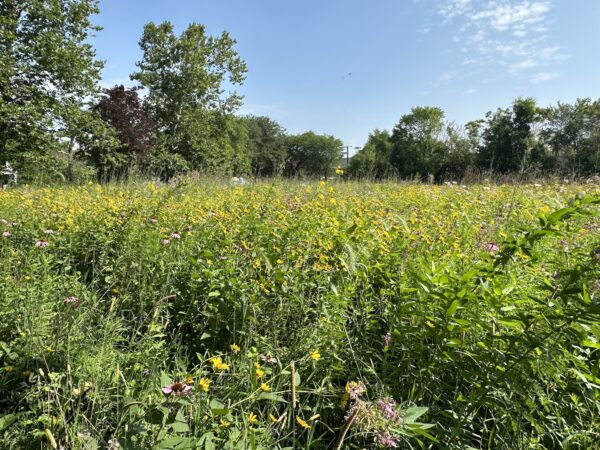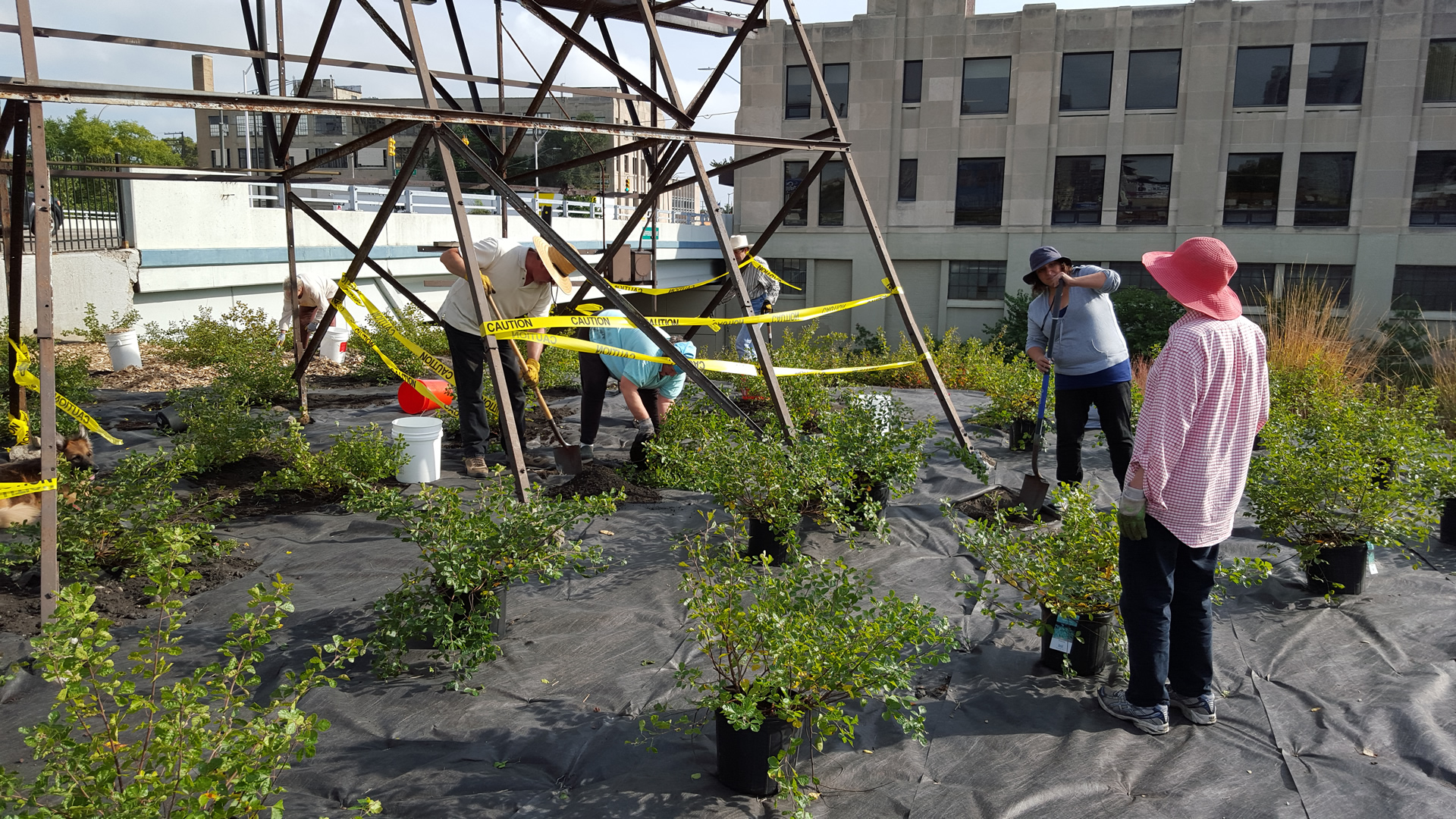
Great Lakes Moment is a monthly column written by Great Lakes Now Contributor John Hartig. Publishing the author’s views and assertions does not represent endorsement by Great Lakes Now or Detroit Public Television.
A recent article published by the prestigious National Academy of Sciences concluded what Detroit Garden Center had long known – that small patches of habitat are important to protecting biodiversity or the variety of life on Earth.
These researchers reported that if we gave up on small patches of vegetation, we would stand to lose many species that are confined to those environments, and biodiversity would decline as a result. Further, they concluded that restoring and reconnecting small isolated vegetation patches should be an immediate conservation priority.
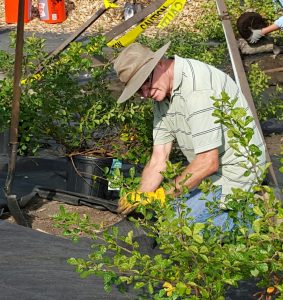
President Ron Smith working the urban garden along the Dequindre Cut, Photo courtesy of the Detroit Garden Center via John Hartig
That is precisely what Ron Smith and fellow Detroit Garden Center gardeners are doing on a small, half-acre patch located at the intersection of East Jefferson Avenue and the Dequindre Cut in Detroit.
This native plant garden is not your normal garden. In fact, it surrounds the parking lot of Ralph Vigliotti Realty on East Jefferson Avenue. The Vigliotti building is separated from its parking lot by the below-grade or sunken Dequindre Cut greenway trail that is so popular with cyclists, joggers, and walkers.
The Cut links the Detroit RiverWalk with Eastern Market, Midtown, and Wayne State University. Detroit Garden Center has literally created a hillside garden of native grasses, perennial flowerings plants, and shrubs overlooking this Dequindre Cut greenway trail.
The Dequindre Cut being below-grade creates a hillside that Detroit Garden Center has masterfully crafted into native habitat that supports biodiversity and ecosystem services — the benefits we receive from healthy ecosystems and natural resources, provides a teachable moment for bringing conservation to cities and helping make nature part of everyday urban life, and helps create a sense of place for people using the Dequindre Cut.
Native plants support pollinators, provide habitat for birds and bugs, and require fewer resources to maintain than most non-natives.
A Passion for Gardening
Ron Smith acquired his love of gardening from his grandmothers and father. His paternal grandmother was a perennial flower grower, and his maternal grandmother lived on a farm where she grew vegetables and had many fruit trees. Ron’s father gained an interest with flowering gardens by working with his mother.
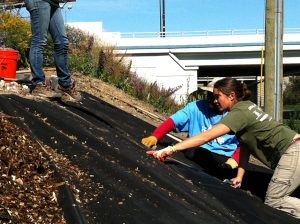
Volunteers planting the hillside garden along the Dequndre Cut, Photo courtesy of the Detroit Garden Center via John Hartig
Some of Ron’s fondest memories are of helping his grandmothers and father garden – working the flower beds, weeding, planting, and pruning.
Ron was a kindergarten and 1st grade public school teacher for 30 years. He went on to get a master’s degree in early childhood education and at the end of his career became an adjunct professor in early childhood education at Wayne State University. His experience in education helped him develop organizational, planning, and leadership skills that he would later put to use in the Detroit Garden Center.
In 1982, Ron bought an old Queen Anne/Victorian home in the Woodbridge neighborhood of Detroit that is bordered by the Lodge Freeway on the east, Grand River Avenue on the south, 16th Street on the west, and I-94 on the north. When Ron purchased his home it had no landscaping to speak of, and he saw this as a clean slate to beautify his surroundings. The first thing he did was to build a patio using reclaimed bricks.
Once the patio was constructed he laid out garden plots in the backyard. He began going to Eastern Market every Saturday searching for plants and asking vendors many questions before deciding what to buy. He realized that gardening at his Woodbridge home was exciting and relaxing, and it soon became an important part of his weekly routine.
Ron’s first interaction with the Detroit Garden Center was at a 2009 Detroit Riverfront Conservancy planning meeting for the Dequindre Cut greenway at the Detroit Garden Center office in the Vigliotti Building. He met then Detroit Garden Center director Barbara Hayes and they quickly hit it off with their common passion for gardening and shared ideas about the landscaping along the future Dequindre Cut.
Barbara invited Ron to the next Detroit Garden Center Board Meeting, and the rest is history. Ron became a member, volunteered at the office, became an advisor to the Board, was elected as president in 2011, and stewarded the creation of the Dequindre Cut urban garden as a gift that keeps on giving.
Gardening’s Life Lessons
But the Detroit Garden Center is much more than the Dequindre Cut native plant garden. The Detroit Garden Center offers excellent horticultural workshops, interesting day- and weekend-long field trips and tours of gardens, and informative educational outreach programs. These programs provide volunteer opportunities, such as working with young girls from Detroit in the Rise n’ Shine summer gardening program and working in the native plant garden on the Dequindre Cut.
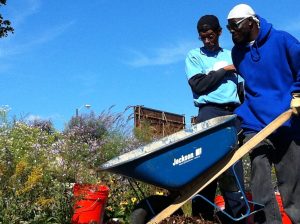
Volunteers working the urban garden along the Dequindre Cut, Photo courtesy of the Detroit Garden Center via John Hartig
Joining the Detroit Garden Center provides an opportunity to meet other gardeners and non-gardeners who have a desire to learn about gardening.
Ron believes strongly that through gardening we can learn to live sustainably, whether in urban or rural areas. What we plant and the types of herbicides and fertilizers we use have a huge impact on the health our ecosystem. Through gardening we learn about how plants are beneficial for insects, birds, and humans. By selecting plants that are native to southeast Michigan we also avoid bringing in exotic species that threaten ecosystem health and integrity.
Detroit Garden Center has a long and rich history, being established in 1932. Current Detroit Garden Center challenges include maintaining and acquiring new members and encouraging young people to get involved with the organization.
Ron believes that through gardening people will form a connection with the land and its biodiversity and can participate in life-long learning, stay physically active, develop a stewardship ethic that can help create a healthier world, and have fun with friends and family. You can also get satisfaction from passing this on to future generations.
For more information about the Detroit Garden Center or on how to get involved visit: ![]()
Featured Image: Planting sumac – Volunteers planting sumac in the urban garden along East Jefferson Avenue, Photo courtesy of the Detroit Garden Center via John Hartig


